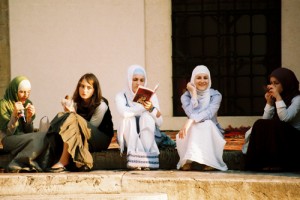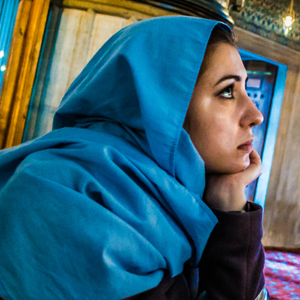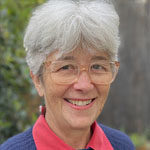A female religious scholar of 15th century Hadramawt, Yemen, al-Shaykha Sultana bint ‘Ali al-Zubaydy was well known for her piety, knowledge, and teachings. One of her male counterparts, expressing the conventional opinion that religious scholarship and teaching were the domain of men, challenged her in verse: ‘But can a female camel compete with a male camel?’ She completed the couplet, responding: ‘A female camel can carry the same load as a male, and produce offspring and milk as well.’[1]
As I approach the mosque in a Middle Eastern city, my all-covering full-length coat and headscarf clothe me anonymously among dozens of other women who are entering through the gates and across the yard, past the places for men to wash, away from the spacious main door of the mosque, to pass behind the curtain hung between the corner of the building and the surrounding wall. The curtain conceals the small side door, which opens to a set of carpeted stairs. Wooden shelves are at the bottom of the stairs and on the landing, and we remove our shoes and leave them in the shelves, making our way up the stairs in socks or stockinged feet.
There is not much furniture in the upper meeting hall: the carpet, some shelves for books at the back, a few plastic chairs, sponge mattresses to sit on around the side of the room, and a desk-and-seat for the speaker. Framed pictures of Arabic text hang on the wall. This is the hall where women come and go for the different meetings, do the ritual prayer (salah), greet friends, softly recite pages of the Qur’an or just sit quietly on the floor. The hall opens onto the balcony overlooking the main mosque area where the men pray. Theirs is the high roof, sense of space: here there is more limited space, a lower roof, looking through balustrade or windows onto the main men’s part below—behind, seeing, and unseen.
Women in the history of Islam
Women in mosques are not new in Islam. Traditions (Hadith) that refuse to forbid women from mosques are ascribed to Muhammad, Prophet of Islam. They support stories that women attended the mosque in Muhammad’s time, including Friday sermons and feasts. However, over the centuries as Islam expanded, men went to the mosque and women stayed at home to pray.
There have been women leaders[2] and teachers throughout the history of Islam. Aisha (Muhammad’s wife) and Fatima (his daughter) are often mentioned, along with some of Muhammad’s other wives and companions, as muhaddithat—women who taught hadith to others. A number of religious histories mention famous women scholars and teachers, women who were active in Islamic law (fiqh), interpreting the Qur’an and giving legal rulings (fatwas), exercising the same authority as men scholars.
Women scholars flourished more in the 7th-8th centuries (the early days of Islam) and 12th-16th centuries (times of disruption and invasion from the Crusaders and Mongols).[3] These women were often taught by a male relative such as their father, and sometimes also had private tutors. Education, a male patron, and often, social class were important factors.
A recent influential example was Zaynab al-Ghazali (1917-2005) in Egypt, who founded the Muslim Women’s Association (Jama’at al-Sayyidaat al-Muslimaat) when she was 18 years old. She claimed it had a membership of 3 million throughout the country by the time the government dissolved it in 1964. She gave lectures to thousands of women who attended each week at the Ibn Tulun Mosque. Her association offered lessons for women, published a magazine, maintained an orphanage, offered assistance to poor families, and mediated family disputes. Al-Ghazali worked closely with the Muslim Brotherhood, and spent six years in prison until released in 1971 by President Anwar Sadat.
The women’s movement in Islam today

The women’s piety movement has roots in the history of women scholars within Islam. However, it is also a contemporary movement, with unprecedented numbers of women involved in the Islamic revival movement, which has spread through the Muslim world since the 1970s. It has become more visible through the increasing number of women wearing hijab. In the 1980s and 1990s a new word mutadayyinat, ‘religious women’, was invented, to describe the growing piety movement among women.[4]
Women’s literacy worldwide has increased at the same time as expanding access to Islamic teaching through pamphlets, cassettes, radio, TV, satellite, and Internet. These two factors have helped to grow the Islamic revival movement and women’s part in it. Some women preachers are self-educated; but increasingly religious institutions in the Muslim world are offering training to women.[5] Al-Azhar University in Cairo began training women preachers in 1999.
Where they face social restrictions, Muslim women have always used religious occasions in the home, such as Qur’anic recitations or recitative prayer (dhikr) to gain blessing. So religious practices provide support for the chance to gather and talk together over a glass of tea or a meal. Women began to organize religious lessons in their homes to learn the Qur’an and other religious materials. Increasingly, homes and special gatherings became used as places where women were encouraged to make sure that their behaviour and clothing fit with what Islam teaches. A birthday party might include a time to urge all the young women attending to wear hijab.
Throughout the world
In the Middle East in the 1990s and early 2000s, women began to move more into mosques for their gatherings, and to become involved in public religious teaching, including on television. Mosque classes train women how to behave as good Muslims, and also how to teach others at community events such as weddings or births. Furthermore local neighbourhood mosques are used as centres to organize activities including both religious instruction and medical and welfare help for Muslims in need.
Elsewhere in the world, in Indonesia from the early 1900s, both the reformist Muhammadiya and traditionalist Nahdlatul Ulama Muslim organisations have offered Islamic education to women as well as men, from grassroots informal religious classes up to Islamic training schools (pesantren). So now large numbers of women are equipped to discuss and teach about Islamic texts and legal rulings.[6]
In China, the growth in women’s mosques and women’s religious culture among the Muslim Hui people has been connected to China’s move in the 1980s towards reform and openness to the outside world.[7] In the Indian sub-continent, the efforts of the conservative Tablighi Jama’at was at first directed at men. However, women are now included among those who travel for shorter or extended periods to promote reformist Islam (while maintaining the rules of purdah).[8]
A new space for women
This has led to a generation of women literate and competent in the Qur’an and the traditions, and able to interpret them with regard to the issues of women’s everyday lives. A growing number of publications by women give women’s perspectives on reading the Qur’an and its teachings. In Malaysia, the Sisters of Islam draw on the religious texts in their effort to enable women and to help them get justice in issues of family law such as divorce.
Women’s authority in Islam has traditionally been in the home and at times of rites of passage, family transitions. Now they are taking up authority in the area of religious texts and teaching. It is still within conservative Islam, and women support their place in mosques and teaching, by conforming to conservative religious practices of dress and general behaviour. By reading the Qur’an and traditions for themselves, to answer the questions from women’s daily lives, they are reforming the role of women within Islam.
Implications and suggested responses
We recognise that Muslims and Christians may both meet questions about the place of women in a conservative reading of our faith and our books. We have common cause in working for women who face unjust marriage or divorce laws, or violence. So there is a place to meet and work alongside women in the Muslim piety movement. We need to bring a robust understanding of the place of women in Christ to our meeting.
It is good to be able to interact with the discussions around the Qur’an, the nature of the Messiah, the authenticity of the Bible—the arguments in which they have been trained. Going beyond argument to telling the stories of Jesus, of his interactions with women—including the place he gave them in his ministry (Lk 10:39, Jn 4); his power to purify (Lk 8:26-56); his refusal to condemn (Jn 8:1-11)—speak right into the aspirations and longings of women in the piety movement.
We can share from our own hopes and struggles, and how Jesus meets and answers us. As we pray, they may encounter the Messiah who is powerfully present to hear and answer our petitions.
The women’s mosque movement reminds us that within the Muslim world, there are different understandings of the place of women, just as there are different understandings of violence and its use. In the end, the basic place of meeting between Christian and Muslim is our shared regard for Jesus the Messiah; and the most fundamental point of difference is not the place of women or of violence, but who we believe the Messiah to be.
Endnote
- Boxberger, Linda. ‘From Two States to One: Women’s Lives in the Transformation of Yemen’. In Women in Muslim Societies: Diversity Within Unity. Boulder & London: Lynne Rienner Publishers, 1998. 119.
- Mernissi, Fatima. Mary Jo Lakeland, trans. The Forgotten Queens of Islam. Cambridge: Polity Press, 1993.
- Nadwi, Mohammad Akram. Al-Muhaddithat: The Women Scholars in Islam. Oxford, London: Interface Publications, 2007.
- Badran, Margot. Feminism in Islam. Secular and Religious Convergences. Oxford: Oneworld, 2009, 8.
- Joseph, Suad, ed. Encyclopedia of Women & Islamic Cultures. Vol V: Practices, Interpretations and Representations. Leiden, Boston: Brill, 2007. 335-354. See Rausch discussing Egypt; Deeb, the Arab States; Huq, South Asia; Ali, Sudan; Demirer, Turkey; and Kalinock on Iran.
- van Doorn-Harder, Pieternella. ‘Translating Text to Context: Muslim Women Activists in Indonesia’. In Women, Leadership, and Mosques: Changes in Contemporary Islamic Authority. Women and Gender: The Middle East and the Islamic World series, vol 11. Leiden, Boston: Brill, 2012. 413–35.
- Jaschok, Maria. ‘Sources of Authority: Female Ahong and Qingzhen Nusi (Women’s Mosques) in China’. In Women, Leadership, and Mosques: Changes in Contemporary Islamic Authority. Women and Gender: The Middle East and the Islamic World series, vol 11. Leiden, Boston: Brill, 2012. 37–58. Also: Jaschok, Maria, and Jingjun Shui. The History of Women’s Mosques in Chinese Islam. Richmond, UK: Curzon Press, 2000. 154.
- http://www.world-religion-watch.org/index.php/about-us-researchers-and-fellows-at-world-religion-watch/research-publications-and-working-papers/284-veil-tabligh-jamaat; also, https://lausanne.org/content/lga/2015-11/understanding-and-engaging-with-the-tablighi-jamaat.
References
Ali, Souad T. ‘Religious Practices: Preaching and Women Preachers: Sudan’. Encyclopedia of Women & Islamic Cultures. Leiden, Boston: Brill, 2007.
Badran, Margot. Feminism in Islam: Secular and Religious Convergences. Oxford: Oneworld, 2009.
Boxberger, Linda. ‘From Two States to One: Women’s Lives in the Transformation of Yemen’. In Women in Muslim Societies: Diversity Within Unity. Boulder & London: Lynne Rienner Publishers, 1998. 119–33.
Deeb, Lara. ‘Religious Practices: Preaching and Women Preachers. Arab States (Excepting North Africa and the Gulf’. Encyclopedia of Women & Islamic Cultures. Leiden, Boston: Brill, 2007.
De Feo, Agnes. ‘Behind the Veil, In the Ranks of the Tablighi Jamaat’. Research. World Religion Watch. 12 October 2009. http://www.world-religion-watch.org/index.php/about-us-researchers-and-fellows-at-world-religion-watch/research-publications-and-working-papers/284-veil-tabligh-jamaat.
Demirer, Yucel. ‘Religious Practices: Preaching and Women Preachers: Turkey’. Encyclopedia of Women & Islamic Cultures. Leiden, Boston: Brill, 2007.
Huq, Maimuna. ‘Religious Practices: Preaching and Women Preachers. South Asia’. Encyclopedia of Women & Islamic Cultures. Leiden, Boston: Brill, 2007.
Jaschok, Maria. ‘Sources of Authority: Female Ahong and Qingzhen Nusi (Women’s Mosques) in China’. In Women, Leadership, and Mosques: Changes in Contemporary Islamic Authority. Women and Gender: The Middle East and the Islamic World series, vol 11. Leiden, Boston: Brill, 2012. 37–58.
Jaschok, Maria, and Jingjun Shui. The History of Women’s Mosques in Chinese Islam. Richmond, UK: Curzon Press, 2000.
Kalinock, Sabine. ‘Religious Practices: Preaching and Women Preachers’. Encyclopedia of Women & Islamic Cultures. Leiden, Boston: Brill, 2007.
Mernissi, Fatima. Mary Jo Lakeland, trans. The Forgotten Queens of Islam. Cambridge: Polity Press, 1993.
Nadwi, Mohammad Akram. Al-Muhaddithat: The Women Scholars in Islam. Oxford, London: Interface Publications, 2007.
Rausch, Margaret J. ‘Religious Practices: Preaching and Women Preachers. Egypt and North Africa’. Encyclopedia of Women & Islamic Cultures. Leiden, Boston: Brill, 2007.
Taylor, Jenny. ‘Understanding and Engaging with the Tablighi Jamaat’. Lausanne Global Analysis. Vol 4, no 6. November 2015. https://lausanne.org/content/lga/2015-11/understanding-and-engaging-with-the-tablighi-jamaat.
van Doorn-Harder, Pieternella. ‘Translating Text to Context: Muslim Women Activists in Indonesia’. In Women, Leadership, and Mosques: Changes in Contemporary Islamic Authority. Women and Gender: The Middle East and the Islamic World series, vol 11. Leiden, Boston: Brill, 2012. 413–35.
van Doorn-Harder, Pieternella. Women Shaping Islam: Reading the Qur’an in Indonesia. Urbana and Chicago: University of Illinois Press, 2006.
Photo Credits:
- Featured image: From ‘Enjoining the mosque‘ by Giuseppe Milo (CC BY-NC 2.0).
- Image two: From ‘Sarajevo, Bosnia‘ by Kashfi Halford (CC BY-NC 2.0).

